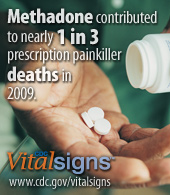Unintentional Poisoning: CDC Research & Activities
Prescription Painkillers in the US – A CDC Vital Signs
Deaths from prescription painkillers have reached epidemic levels in the past decade. This Vital Signs provides information on latest findings, risk factors, U.S. State information, and what can be done.
Policy Impact: Prescription Painkiller Overdoses
Prescription Painkiller Overdoses is one in a series of issue briefs highlighting key public health issues and important, science-based policy actions that can be taken to address them. Through this publication, CDC supports state-based efforts to reduce prescription drug abuse while ensuring patients have access to safe, effective pain treatment. The publication includes information about deaths and emergency department visits resulting from prescription painkiller overdoses, overdose trends, the most common drugs involved, and the regions and populations most severely affected. Recommendations on how health care providers, private insurance providers, and state and federal agencies can work to prevent unintentional drug overdoses are also included.
Study of Opioid Poisoning Risk in Medicaid-enrolled Populations
During 1999–2006, the number of poisoning deaths in the United States nearly doubled, largely as a result of deaths involving prescription opioid painkillers. CDC researchers found that, in 2006, the rate of poisoning involving opioid painkillers in Washington State was significantly higher than the national rate. Researchers found that, in Washington from 2004 to 2007, 1,668 people died of prescription opioid-related overdoses. Of those, 45.4% percent were Medicaid -enrolled, and this population had a 5.7-fold increased risk of prescription opioid-related overdose death. Methadone was involved in almost two -thirds of these deaths. Efforts to minimize this risk should focus on assessing the patterns of opioid prescribing to Medicaid enrollees and intervening with Medicaid enrollees who appear to be misusing these drugs.
National Drug Overdose Prevention Meetings
CDC’s Injury Center organized two national meetings to focus on strategies to prevent and control the emerging threat of unintentional prescription drug overdoses. The first meeting, in December, 2008 sponsored jointly with CDC’s Public Health Law Program, was “Promising Legal Responses to the Epidemic of Prescription Drug Overdoses in the United States.” This meeting focused on promising legal strategies for addressing the pharmaco-epidemic, and included presentations on topics such as state prescription drug monitoring programs, interstate prescription data sharing, drug courts, specialized state prescription forms, doctor shopping statutes, pain clinic legislation, return of unused pharmaceuticals, and state physician prescription guidelines.
The second meeting, entitled "State Strategies for Preventing Prescription Drug Overdoses,” in January, 2009 included participants from state public health programs and medical representatives. Presentations covered such subjects as surveillance and use of data, a Medicaid patient review program in Washington State, a Department of Defense pharmacy monitoring program, medical guidelines for prescribing opioids in Utah, a community naloxone program in North Carolina, and management of frequent emergency department users.
The next step from these two meetings is identifying the most effective strategies through evaluation.
Prescription Drug Overdose: State Health Agencies Respond
To assess the knowledge, response, and planning regarding prescription drug misuse and overdose, in late 2007 the Association of State and Territorial Health Officials (ASTHO) and CDC conducted interviews with state and territorial health officials and other senior leaders in nine states (Arkansas, Florida, Indiana, Kentucky, Montana, North Carolina, Oklahoma, Utah, and West Virginia). The resulting report, Prescription Drug Overdose: State Health Agencies Respond, outlines the state perceptions, partnerships, recommendations, policies, and other issues that are fundamental to understanding and responding to drug misuse. Order a free copy or download a PDF version.
Study of Prescription Use Related to Overdose Deaths
While types of drugs involved in prescription drug overdose deaths can be determined from medical examiner and emergency department data, the patterns of prescription use leading up to these overdoses have not been well described. To help in this effort, CDC Injury Center scientists conducted a study to compare the prescriptions used among people who died of drug overdoses with the prescription use of a control group of other users of controlled prescription drugs (CPDs). This project linked information from the New Mexico prescription drug monitoring program (PDMP) and the New Mexico state medical examiner. Risk factors examined included prescriptions for specific drugs, the number of prescriptions, providers, and pharmacies, and overlapping prescriptions. The study found that increased risk of overdose was associated with male sex, one or more sedative/hypnotic prescriptions, greater age, number of prescriptions, and having a prescription for buprenorphine, fentanyl, hydromorphone, methadone, or oxycodone. Overdose risk was also significantly increased in patients receiving a daily average dose of > 40 morphine milligram equivalents.
Get email updates
To receive email updates about this page, enter your email address:
Contact Us:
- Centers for Disease Control and Prevention
National Center for Injury Prevention and Control (NCIPC)
4770 Buford Hwy, NE
MS F-63
Atlanta, GA 30341-3717 - 800-CDC-INFO
(800-232-4636)
TTY: (888) 232-6348
New Hours of Operation:
8am-8pm ET/
Monday-Friday
Closed Holidays - cdcinfo@cdc.gov




